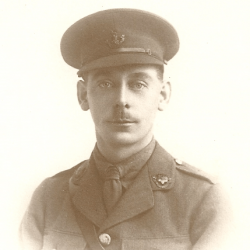The following is a transcription of a newspaper article describing the Turkish attack on the Allied Forces defending the Suez Canal on the night of February 2/3, 1915. All images have been added by the author and were not part of the original newspaper articles.
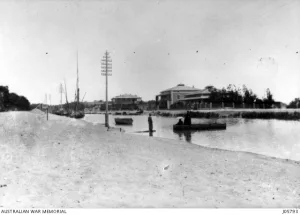
Ismailia on the Suez Canal. [Source: Australian War Memorial]
ON THE CANAL
THE FULL STORY OF THE FIGHTING
Al Mokattam publishes the following details on the German-Turkish expedition against Egypt, which, says our contemporary, fill in and complete the story as given in the official communiques.
It is now proved that the expedition which attacked the Canal in the first week of February wished to cross at all costs. The Turkish Army had camped in two places 40 miles east of the station of Serapeum, at Mon Dorat, and Makshid. Their base of operations was in a deep valley. When they advanced to the west, they divided into two columns, the smaller marching on Kantara and the larger on Serapeum by the way of Kataib El-Nakhl. This second column was 20,000 strong. British airmen scouts saw this column and informed their headquarters.
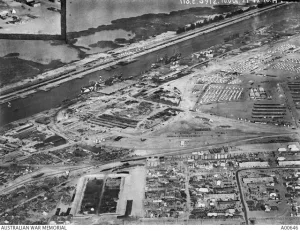
Aerial View of Kantara [Source: Australian War Memorial]
When this force was at a distance of seven miles from the canal it moved backward and forward for reasons which are still unknown, but as soon as the wind blew from the south the attacking army marched towards the canal.
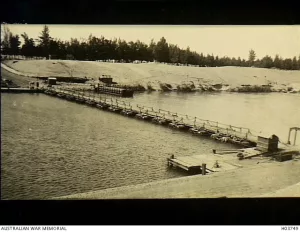
Pontoon bridge across the Suez Canal at Serapeum. [Source: Australian War Memorial]
The influence of German generalship was evident in all the units of that force; one of the proofs of their vigilance is that an English flying machine which flew over the Turkish army was repeatedly shot at but without any effect.
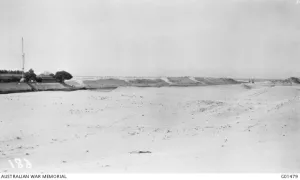
Toussoum Station. [Source: Australian War Memorial]
The Turkish army continued to march forward during the whole night until it came near the canal where it divided into two parts; the larger stopped at a distance of two miles from the canal to wait in reserve and the second which was composed of a whole brigade marched forward to prepare a place on the bank of the canal for the troops to cross at. This force had a number of boats each of which was carried by 40 men. It began attacking about 3:30am at a point to the south of the station of Toussoum and at a mile from it. The night was dark and the enemy had chosen three points at which to cross the canal. On the east bank, opposite the station of Toussoum, some English sentries who were stationed there saw, on the night of 2-3 February last, shadows advancing which they knew must be the enemy. They therefore fired their rifles to warn the British forces that the enemy was advancing. Shortly after they began firing on the British forces, and thus both sides of the canal were as if on fire. The enemy made a great noise and was seen pushing the first boat into the water, and it was followed by the 2nd, 3rd and 4th.
The enemy placed three Maxim guns at that point to protect the boats crossing the Canal.
The Egyptian and territorial artillery took part in the battle, and the prow of the first boat was hit with a shrapnel shell which killed the soldiers and sank the boat. The second and third boats were then pushed from the shore and shot at, the shells smashing in their sides. They soon capsized and most of the troops in them were drowned a few only escaping with their lives. The rest of the boats met with the same fate with the exception of two which were not launched. About 20 men crossed to the west bank of the Canal by throwing themselves into the water to escape the fire which was poured on them, and surrendered to the British troops after having tried to dig holes in which to hide themselves until the battle was over, being afraid that the British troops would kill them if discovered. Being unable to dig these holes they sat where they were until discovered by British troops who took them prisoners.
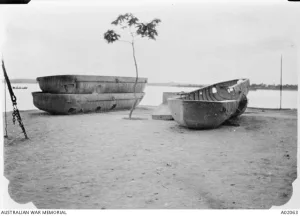
Captured Turkish Pontoon Boats. [Source: Australian War Memorial]
From the shells of the enemy’s guns, it was evident that they had no guns of greater calibre than 6 inches. It appears that the enemy had a good supply of ammunition for it did not spare it but rained it over our trenches though without hitting them. A shell exploded close to one of the British guns but it killed no one and although the enemy tried to discover the position of our artillery they failed.
At dawn the battle raged over a distance of two and a half miles, that is to say between the stations of Serapeum and Toussuom. The enemy fought bravely against the Egyptian, Territorial, Indian and New Zealand troops. The greater part of the enemy’s forces were opposite the station of Toussuom where they outnumbered our troops by ten to one, and yet the British troops stood their ground and prevented the enemy from moving forward. This proves that the military authorities had taken all the necessary steps for defence and were aware of all the difficulties in the way of an invading force crossing the Canal.
Signs of disorder among the enemy began to appear, and they retreated behind the earthworks they had hastily thrown up on the eastern bank of the Canal. But the British artillery continued to shell them in their retreat and inflicted heavy losses upon them.
TERRITORIAL ARTILLERY IN ACTION
One of the territorial batteries, commanded by Major Dobson, particularly distinguished itself. It is worthy of note that the officer controlling fire of this battery climbed up a palm-tree close by to be able the better to guide the battery and remained at his post an hour and a half under heavy fire. At last when no longer able to maintain his position he came down and climbed another palm-tree and remained there till the battle was over.
The enemy tried to attack us again but the Indian troops repulsed them with heavy losses.
The British troops took many prisoners; one officer confessed that they wanted to take our troops by surprise, but admitted that they found them very much on the qui vive. [on the alert]
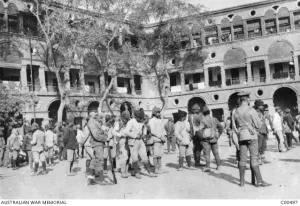
Turkish Prisoners at Kasr-el-Nil Barracks. [Source: Australian War Memorial]
The British and French cruisers and battleships fired on the enemy’s reserve – which was at a distance of two miles on the eastern bank of the Canal – obliging them to retreat at 6pm. Some of the enemy’s troops continued hiding on the night of Wednesday on the eastern bank of the Canal, and kept up a desultory fire on our troops.
On the following day (Thursday), a part of the enemy was seen entrenched on the eastern bank. Two companies of Indian troops then crossed the Canal and attacked them, and as soon as reinforcements arrived the enemy was surrounded and thus obliged to surrender. These soldiers were 250 in number and were among the enemy’s best troops.
It now appears that the name of the German officer who was found killed on the field of battle and had a white flag and some seditious writings in his possession was von der Hagen. He was buried on a height on the east bank, and the Turkish troops were buried lower down at the point at which they tried to cross the canal.
THE HARDINGE’S PILOT’S BRAVERY
The cruisers and battleships fired on the enemy from Lake Timsah. The pilot of one of them, the converted cruiser Hardinge, Captain Dario, had, while on the bridge his leg shattered and his arm badly wounded. Those who saw the conduct of this pilot said that it was worthy of the highest admiration, for when shot, he caught hold of the railing and looking at his leg to ascertain the amount of injury done to him, refused to be carried to his cabin and asked for a long chair to be brought him saying that he still had strength enough to take the ship to port. But the doctor ordered him to be taken to his cabin notwithstanding his protests.
The authorities estimate the force of the enemy which attacked the canal at nearer 30,000 than 20,000 men, and the number of the wounded and prisoners is 5,000.
The enemy has retired to the east and is beyond the scope of our aeroplanes which is 60 miles.
FIGHTING NEAR TOR
TURKISH FORCE ANNIHILATED
Cairo, Sunday
A small British force landed in the Sinai Peninsula north of Tor and surprised a body of 200 Turks who were preparing to attack Tor. The Turks were annihilated. We captured 100 prisoners and 60 dead were counted on the field. The enemy’s camp and stores were destroyed. Fifty Turks, commanded by two German officers, previously reconnoitered the position which they believed was undefended, but retired when they found it was garrisoned by 200 Egyptians.
Reuter

